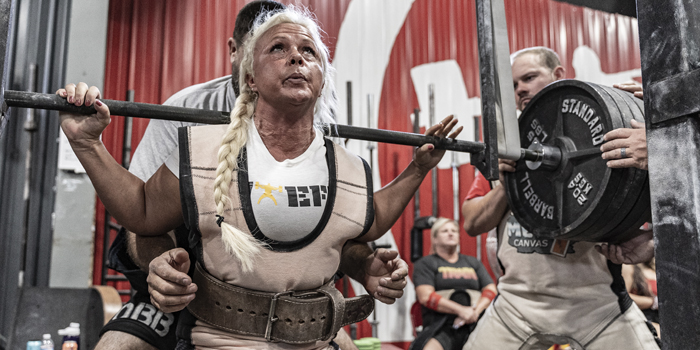
Scrolling through Instagram, this is the kind of stuff that makes me want to gouge my own eyeballs out.
How to train Instagram Conjugate in 2022:
- Pick a random max-effort variation
- Work up to a single that's at best an 8RPE
- Take an aggressive jump and miss at your sticking point
- Half-ass one accessory lift
- Go home
- Forget that there is a dynamic effort day
- Repeat for 12 weeks
- Make a post apologizing for the meet not going the way you wanted it to
Posting #CONJUGATEAF #WESTSIDE4LIFE #BANDZ #CHAINZ along with your dogshit training is the half reason that people can form an argument against the use of conjugate for raw lifters. First off, if that's what your training looks like, you are not training conjugate. Second, if that's what your training looks like, you shouldn't be surprised if you aren't getting better—you aren't doing the work necessary to drive progress.
*If you don't have a background with conjugate periodization, check out the four-part series I wrote for elitefts: Four Max Effort Principles to Master, Five Dynamic Effort Principles to Master, Five Repeated Effort Principles to Master, The Big Picture of Conjugate.
Max Effort is Only Part of the Equation
The idea behind conjugate periodization is that by training multiple attributes concurrently, those attributes will complement each other and improve simultaneously. Those attributes can be categorized based on the development of maximal strength, explosivity, muscular endurance, or cardiovascular conditioning (depending on who you're talking to, the development of hypertrophy could be considered an attribute of its own or a by-product of training the others). Strength, explosivity, endurance, hypertrophy, and conditioning can all be increased simultaneously, albeit at different rates depending on the prioritization of training and the athlete's needs.
In powerlifting, our goals will always be biased towards maximal strength development, but the other attributes still hold influence over the weight on the barbell. You don't need to be a marathon runner, but if you are in better shape, you can handle more workload in training. You don't need to be Mr. Olympia, but a larger muscle has the potential to be a stronger muscle and can improve your leverages. You don't need to dunk a basketball, but being more explosive can help you blast through a sticking point. The other attributes' influence on maximal strength might not be direct or immediate, but the effect will be complimentary if you find the sweet spot for each in training.
When I say the effect will be complimentary, I mean there is a "chicken or the egg" relationship between maximal strength and the other attributes. Improving your submaximal work capacity will increase your capabilities on max effort work. Improving your maximal strength will enhance your tolerance to submaximal loading. In conjugate periodization, each aspect is built upon everything else, and each aspect builds everything else.
You will touch on each attribute with linear periodization as the reps drop and the intensity rises through your training cycle. The singles performed towards the end of a linear meet prep are designed to translate the higher rep work from earlier in the cycle towards the display of maximal strength. Those singles aren't making you directly stronger—they are building the coordination necessary to show the strength you've already built. In conjugate periodization, the max effort work serves the same purpose by taking everything else you are doing in the gym and applying it to your ability to hit a max single.
There needs to be a base to support max effort work to work. What will the max effort work build off if you haven't done any submaximal work? Your secondary barbell work is essential. Your dynamic effort work is essential. Your higher rep hypertrophy and endurance work are essential. Every piece of the puzzle in conjugate periodization is essential.
Doing Better Max Effort Work
We need to ask if our max effort work is providing the stimulus necessary to tie the rest of our training together. Take another look at the Instagram ConjugateTM example: if all you're doing is one single that barely counts as a work set, taking a big jump, missing, then going home—did you even train anything? Did you provide enough stimulus to generate an adaptation?
To get better at pushing through a near-maximal single, YOU NEED TO PUSH THROUGH SOME NEAR MAXIMAL SINGLES. You need to take jumps on max effort day that allow for three or four reps that count as max effort—reps where you are forced to strain. You need to take jumps that allow you to practice grinding through your sticking point—not hitting them like they're a brick wall.
An 8RPE single, a big jump, then a sketchy rep or miss isn't hardcore. It's not sending it. It isn't training anything. It isn't helping you improve on the platform. If anything, it's teaching you to hit your sticking point and quit. By taking smaller jumps in training, you might sacrifice some weight on your top set, but we aren't doing max effort work for gym numbers; we are doing it to translate to our abilities on the platform.
Volume is Still Important
I used to hate the statement, "Volume is the primary driver of strength and hypertrophy." It is often said to support a higher-volume/higher-frequency approach to training. As such, I used to think it was an argument against max effort work, against conjugate, and against the use of continuous higher intensities in training.
When I hated it, I didn't understand its meaning. It isn't a statement in contradiction to intensity-based training philosophies but a reminder that even in training philosophies dependent on higher intensities, the need for adequate training volume still exists.
Volume in conjugate periodization can be looked at as the volume dedicated to a specific intensity range/training attribute or as the total volume within the program. With a single attribute, it's not a matter of more volume is always better, but whether the right amount of volume was acquired at a given intensity range to drive the athlete forward. When looking at an entire program's volume, it's a matter of teetering the line between the maximum total volume that can be recovered from and what is the minimum required to create a stimulus.
The amount of volume required in each intensity range and in total will vary with the athlete, where they are in their training career, and their needs specific to them. Too much work above 90% in a conjugate program can be just as, if not more, detrimental than too little; the same can be said for each intensity range.
How do we know how much work we need? A combination of time under the bar, experimentation, and the ability to take an honest look at your training, your efforts, and your progress.
If you're starting from scratch, use a top-down approach: make sure you are getting three to four hard reps in on your max effort days. From there, raise your dynamic effort volume as high as you can without detracting from what you are doing on max effort day. Next, increase your secondary work as high as you can without detracting from your max effort or dynamic effort. Lastly, increase your accessory volume as much as possible without taking away from anything else.
You get to that point, and you will be doing a solid amount of work. As you adapt to it, you can build from the bottom up. Bump your accessory work up, and it'll bring up what you can do on your secondaries. Do more on your secondaries, and you'll be able to handle more on your dynamic effort and max effort work. When your capacity for max effort work starts improving, go back to the bottom and start the process again.
Max effort work is not about the weight on the bar in a single training session, but creating a stimulus that will allow us to put more weight on the bar come meet day. Max effort work may be the most competition-specific aspect in a conjugate program, but that does not mean that its importance overshadows the other components. To make conjugate periodization work, for raw and multiply, it's a matter of dedicating the right amount of work to each component of the program to drive us forward.
Seth Albersworth is a powerlifter with experience in and out of gear. His best totals are 2105 pounds raw and 2408 pounds multi-ply. Seth has completed his bachelor's degree in kinesiology from the University of Calgary and recently graduated from Palmer College of Chiropractic's Florida Campus. He's in the process of acquiring licensure as a Doctor of Chiropractic.











1 Comment